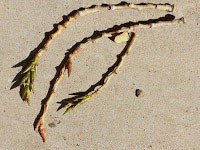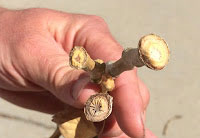Adapted by Steve Geist, Senior Consulting Arborist, Swingle Tree, from the CO-Horts blog originally authored by Mary Small, Jefferson County.

Dropped Cottonwood Branches |
Cladoptosis
This phenomenon is known as “cladoptosis”, one of those “osis” words that strikes fear into the hearts of many. Fortunately, cladoptosis is a naturally occurring twig drop common to many tree species, including cottonwood.

“Ball” of dropped branches |
Take a look at the bottom of the fallen, pencil sized branches underneath the tree. You’ll see nice, clean cut with a rounded, raised center. If you tried to reattach the dropped branch to where it was originally connected, you’ll see the two pieces make up a ball and socket arrangement. This is a big clue that the tree was an active player and the branch drop wasn’t caused by squirrels chewing or storm breakage or something else.

“Socket” on tree branch |
Before the branch fell from the tree, specialized cells created a separation layer where a break occurs. The cells also created a protective layer covering the opening in the branch remaining on the tree. This helps protect against moisture loss.
why does cladoptosis occur?
Researchers are unclear why cladoptosis occurs. It’s thought to be stress related. Affected trees may be suffering from problems such as soil compaction issues or drought. Cladoptosis is more prevalent during the hot dry summer months. The tree is stressed, so it “cuts its losses” by shedding less vigorous plant material, enabling it to better support more vigorous portions. Cladoptosis may also function like leaf drop, a sort of “planned senescence”.
To reduce this twig drop, improve water applications and reduce compaction in the tree’s root zone to improve its overall health. Cladoptosis is an annual occurrence in many trees.



